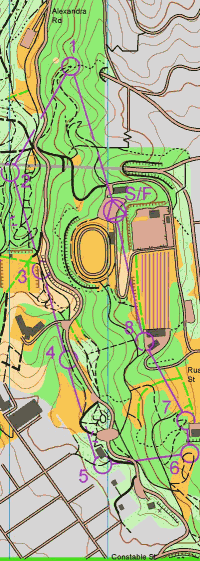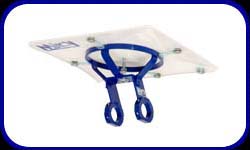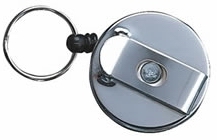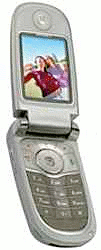Riding Hints
How is the Course Marked?
 You get a map with a numbered series of circles, called "control points". The start is a triangle. At the control points there will be a flag and clipper. You prove you have been there by clipping in the right box on your control card. Some events use electronic boxes at the controls, and you carry an e-stick which records your visit.
You get a map with a numbered series of circles, called "control points". The start is a triangle. At the control points there will be a flag and clipper. You prove you have been there by clipping in the right box on your control card. Some events use electronic boxes at the controls, and you carry an e-stick which records your visit.
Between the controls, there are no course markings (with one or two exceptions, below). You use the map to get there. And usually there is a choice of routes you can take.
Controls Usually in Sequence
Usually you have to visit the controls in sequential order. Riders start at 1, 2 or 3-minute intervals, and you and your bike must visit all the controls in the right order to be classed as a finisher. Fastest time wins.
There's an alternative called a "Score Event" in which you can visit controls in any order within a time limit. Usually everybody blasts off at once. Controls have various scores, and highest score (less a stiff lateness penalty) wins.
No Control Descriptions
Orienteers are used to a list of the features the controls are located on, but since controls are all on tracks these aren't used in MTBO. Just navigate to the centre of the circle on the map! There's a control code on the flag, which should match the one on the map. That's printed in brackets or separated by a dash from the control sequence number.
Tracks Only (Some Exceptions)
The rule is you must travel only on roads or tracks marked on the map. That usually surprises foot-orienteers, until they find out how hard it is to read the map on the move! (New Dec 2011: You can travel on certain colours but it will be fairly slow. Riding on tracks is the norm.)
We sometimes make "tracks-for-the-day" by marking a route with intermittent or continuous coloured tape. There'll be a sample of this tape at the start. The tape is sometimes also used on indistinct junctions so that you know what we consider to be a track
Navigation and Riding Ability
The course is supposed to equally test navigation and riding ability. A big part of the navigation is deciding the best route from two or more possibilities. The shortest way isn't always the quickest, you should compare the number of contours you will have to climb. And you can take into account the map information about rideability. Foot-orienteers, you should look much further off the beeline than you are used to, including going back the way you came!
Bikers: it's worth taking time to suss out the best way, even if it means stopping. Going down the wrong track can waste more time than riding brilliance can make up. Remember the hare and the tortoise!
Reading the Tracks
 If the map is specially made for MTBO, the roads and tracks are shown with two different widths and four different speed values.
If the map is specially made for MTBO, the roads and tracks are shown with two different widths and four different speed values.
- Sealed roads: Shown as two black lines with brown between.
- Easy Riding: Gravel roads are shown as a thick black line. A maintained Singletrack (under 1.5m) is a thin black line. Note that "easy" refers to the surface only, you'll have to interpret the contours to get an idea of the slope.
- Slower Riding: The next category is unmaintained tracks, where riding is slowed a bit, particularly when the ground is wet. They are shown using either the thick or the thin black line, but with long dashes. It would be rare for a skilled rider to have to get off because of the track surface. These are well worth choosing if they save you a longer way round or a climb.
- Very Slow Riding: The next category is unmaintained tracks, where riding is slowed a lot. The average rider can still ride if there is no climbing involved, but you are "picking your way" over ruts and rocks, or pushing your way through vegetation. It may not be worth riding if it is uphill. They are shown using either the thick or the thin black line, but with short dashes. These are only worth choosing if they save you a lot of distance/climb or sometimes (for good riders) if the direction is downhill.
- Impossible to Ride: The last category is for tracks with obstacles which make riding virtually impossible. They are shown using either the thick or the thin dotted black line. Getting off would be frequent even for a skilled rider, even on the level or downhill. Courses won't have much of this because it isn't fun to ride, but you may have to trade off a short section of "dotty" against the long way round. Don't attempt a long stretch unless there is no alternative!
- Old maps Up to recently there were only THREE speeds. There are still some maps with only one type of dashed line, you'll have to expect a wide speed range for this. Check the legend.
Sometimes when there aren't many tracks on the area, we invent "virtual tracks" to give you more choices of route. On the map you will see a green version of the track symbol above. On the ground you will see... nothing. They are usually in open grassy areas, and usually follow some feature, eg a fence. Sometimes they go straight across an open area between two bits of forest, where the absence of a visible track would otherwise prevent you riding.
This is a NZ invention and may not apply in other countries. To sum up, a green line means "allowable route, no visible track".
Other Symbols on the Map
Forest is usually shown as light green. Open land is yellow (Think of a haypaddock). Green dots on yellow - somewhere in between, ie scattered or very young trees. Water is blue. Contours are brown.
There are special colours where you are allowed off-track. This is new and it may take a while for some maps to catch up - consult the legend. WHITE is forest that you may use - but speed is fairly slow at 25-50%. BRIGHT YELLOW (as opposed to pale yellow) is open land that you may use - also 25-50%. The purpose of these is to make it clear where you can go in areas where tracks are indistinct, or two tracks almost touch.
The map shows things you can see from the track. Examples might be power pylons, water tanks, cliffs. Special attention is paid to the shape of junctions, and whether they are distinct or not. (A small gap indicates an indistinct junction.) A bridge is shown by the road or track crossing the blue line, otherwise there's a gap.
Tracks you're not allowed to use have purple crosses or a purple zigzag on them. Whole areas you're not allowed to use have purple shading on them. Don't get us into trouble with the community, we want to be able to ride here again.
A purple bar across a track is used for an obstacle that will force you to dismount - eg a gate or fallen tree. It's perfectly allowable to go over an obstacle, this is merely something you might take into account when deciding which route to take.
There's a legend on the map, and you should be able to check it out before the start. There are some (beginner) MTBO maps on the Orienteering Hutt Valley website. Do a search on "MTBO".
Know What you Expect to See
Before you ride a single metre, work out what you should see. Eg "go into forest, road bends 90-deg to the right, then take the next left. Should be a single-track". The more you orienteer the more information you will pick up off the map. If things aren't working out, stop, count to 10, and take your time to work out what you have passed since you positively knew where you were.
No Water on the Course
Orienteers expect water points on the course. Because you can readily carry water on a bike there won't be any. Come prepared with water bottles or bladder.
Carrying your Map and Card
 Ideally you need to be able to see your map on the move, so a carrier on the handlebars is a big help. The best ones have a pivot that lets you rotate the map to line up with the way you are going. For example go to the MAPsport SHOP website. The cheapest ones are made of tin-lids, ice-cream containers, you name it. For example go to the resources section of this website.
Ideally you need to be able to see your map on the move, so a carrier on the handlebars is a big help. The best ones have a pivot that lets you rotate the map to line up with the way you are going. For example go to the MAPsport SHOP website. The cheapest ones are made of tin-lids, ice-cream containers, you name it. For example go to the resources section of this website.
Orienteers are used to holding their thumb on the map at the current position, and this is even more useful on the bike when you might only have a few seconds to glance at the map. Some orienteers have fitted their mapholder with a thin sheet of steel, and a powerful magnet can act as your "thumb" to mark position.
The normal orienteering clipper is on the top of a 1m stake. If these are used, the best way to carry your control card is tied on your wrist with elastic or a big rubber band. (It's got a couple of holes punched in it and is made of tough synthetic paper.)
The New Zealand rule is that the control card is attached to the bike by the organisers. If we use this method we hang the clipper on a long enough string to reach your bike. It will be attached to the control flag which will be hanging from something on the side of the track.
If electronic punching is used you should acquire one of those pull-out "zingers" that some people use to attach their security card. This way your e-stick can be (a) attached to the bike and (b) reach the control box on its stake. Clever people can e-punch without dismounting!
What About my Compass?
 As long as you don't use the "magnetic thumb", a clip-on compass (eg Silva Type 19) can slide on the side of your mapboard. But the magnetic thumb is very powerful and you can’t have a compass that close to it. And the clip-on compass is not well-damped, it shakes a lot.
As long as you don't use the "magnetic thumb", a clip-on compass (eg Silva Type 19) can slide on the side of your mapboard. But the magnetic thumb is very powerful and you can’t have a compass that close to it. And the clip-on compass is not well-damped, it shakes a lot.
The best solution is to cable-tie a good-quality thumb compass to the top tube near the stem, with a little bit of foam between to insulate it from the vibration. (A standard compass is a bit big for this.) Or slide a clip-on compass onto one of your gloves so that it sits on the back of the hand.
Safety and Consideration for Others
 Wear a helmet. The route may be on public roads and forest roads that have vehicle traffic so you should take due care.
Wear a helmet. The route may be on public roads and forest roads that have vehicle traffic so you should take due care.
Even on tracks you should ride as if you're going to meet yourself coming the other way. If you're coming up fast behind a slower rider, call out the side you are going to pass on, eg "on the left!" If someone comes up behind you, look for an opportunity to let them past. On single track use the MTB convention that downhill gives way to uphill. If you don't know which way to go at a junction, get off the track while you decide.
The tracks are open to other users too, be courteous to them. Report to the finish, even if you decide to abandon the course. After doing a search we get very annoyed to find you've just gone home!
Contingency Plan for Injuries
 We don't put marshalls on the course so we rely on you, the other competitors. Each incident is different, but hopefully the first rider on the scene can give first aid while the second can head straight to the finish and report to the controller. The controller will have a rescue plan including who would go out on the course and what vehicle they would use - 4WD might be needed for some areas.
We don't put marshalls on the course so we rely on you, the other competitors. Each incident is different, but hopefully the first rider on the scene can give first aid while the second can head straight to the finish and report to the controller. The controller will have a rescue plan including who would go out on the course and what vehicle they would use - 4WD might be needed for some areas.
We encourage carrying a cellphone, and try to put a contact number on the map. But you mustn't use it except in an emergency.
Bike Problems
It's OK to offer help or tools to other competitors, that's over to you. But outside help is forbidden, you've got to complete the course with what riders take into it. The only navigational aids allowed are the map provided, a compass, and an odometer. If your cycle computer incorporates a GPS you mustn't use its information; though recording your track for looking at later is good fun.
More Help
- Here is an expert's advice on what he would look for on an actual course. It was a beginner event on the banks of the Hutt River.
- Here is a Sample Legend which shows most of the symbols that you are going to need.
- Here are the NZ MTBO Rules. A simple statement of what you can and can't do out on the course.
